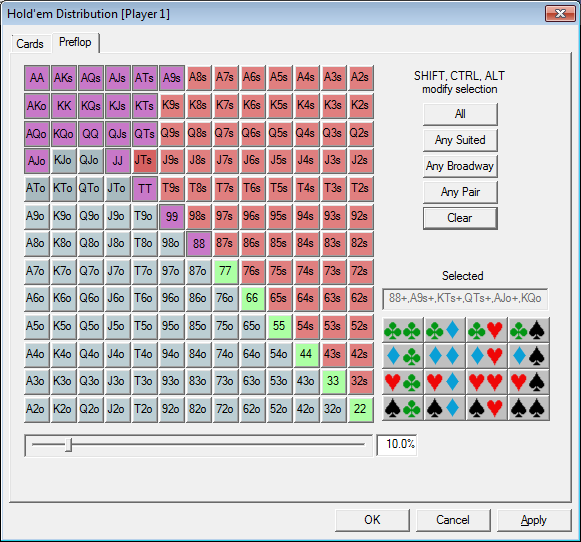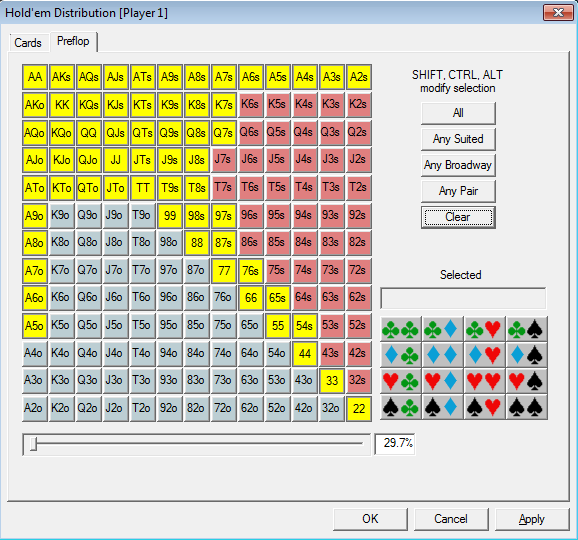Putting Your Opponents On Accurate Ranges Of Hands
Can Help You Choose The Best Strategy To Beat Them.
This Article Introduces Hand Ranges And How To Use Them To Your Advantage.
Putting an opponent on an exact hand is difficult enough by the river. Doing this pre-flop, especially when there is little significant betting action, is almost impossible! What experienced players do instead is assign a range of possible hands that a player might have. This is then narrowed down as the flop, turn and river betting rounds take place – leaving a smaller number of possible holdings by the end of the hand. With practice, this method will massively improve your results – instead of guessing you will be working with probabilities and logical deduction.
I’ll start by explaining what a hand range is and how these are shown. Next I explain how a free tool called PokerStove can be used to visualize different ranges, and turn a percentage likelihood of betting into a range of possible hands. After that I will explain some of the factors which influence pre-flop ranges and how to combine ranges with information you gain after the flop. Finally I’ll go ‘advanced’ with a fantastic tool and a note on how card distribution math can be tied in with hand range thinking.
This is a long article, since getting to grips with assigning ranges is a key poker skill. If you enjoy the info here, please take the time to share.
Don't forget, applying hand reading is even more effective against weak opponents – find out which is the best place to play online poker tournaments in our Best Poker Tournament Sites section.
Planet Mark’s Rec: America’s Cardroom are crushing it for online poker tournament events that welcome both US and worldwide players. ‘The Venom’ tops the list, add to this the popular OSS events, PKO games and a packed regular schedule with guarantees that are growing all the time.
Best of all, you can get your bankroll off to a flying start with a huge 100% welcome deal using referral code SNGPLANET.
Check out the latest promos and tournament events for yourself now at www.americascardroom.eu!
What Is A Hand Range?
Every player has a number of starting hands which they are willing to raise, limp or call raises with pre-flop. There are big differences between individuals, some people play literally any two cards (we have all seen them!), while at the opposite end some people wait for premium hands – perhaps aces, kings, queens or ace-king. In between there are differences in terms of peoples preference for suited cards, aces with different strength ‘kickers’, connecting cards and pairs.
Within those differences we can see distinct patterns. For example, a player who will rarely open the betting from under-the-gun at a full table could have a pair of tens or better, ace-queen off suit + and is unlikely to hold suited connectors or suited aces. In contrast an aggressive player who sees the action folded to them on the button could have a huge range of hands, sometimes as wide as 70% of possible holdings.
When you write hand ranges down this is usually in terms of the smallest pair and ace+kicker, along with suited and offsuit non-ace combinations. For example 55+, A8o+, J9s+ would indicate pairs 55 or better, ace-8 suited or better (which would usually include Ace-10 offsuit) and jack-nine suited or better.
While giving people ranges like this can seem confusing at first – there is a great free tool which can help this to become an easy-to-visualize and (eventually) automatic process.
Using PokerStove To Assign And Visualize Hand Ranges
PokerStove is a free tool which I see as a must have. There are several uses of this calculator, including comparing the winning chances of hands (for example 88 vs AKo), comparing hands to ranges of possible hands (for example how does 88 fare against a range of 66+ A10o+ and KQ?) and finally turning the probability of someone raising into a range of hands.
Notice: The PokerStove website is currently down. Instead I recommend The Slice Poker Equity Calcultor, by ev++, as an alternative. By hitting 'Player 1' on the main screen you will find the same visual hand range as shown in the pictures below - this tool is currently free and has plenty of great features.
For example, say you estimate that a particular opponent raises 10% of the time in a given situation. What would be a good default range of starting hands to assign to them? By clicking ‘Player 1’ on the first screen, then hitting the ‘preflop’ tab you get a display like the one below. Enter 10% (or use the slider) and you see that this is equal to a range of 88+ A9s+ AJo+ and QTs+

You can do this the other way around too by selecting hands on the board. For example I decided an opponent would play any pair, any suited ace, unsuited aces with 5 or better kicker, most suited connectors and a ton of suited 2-gap and broadway cards + any 2 unsuited picture cards… this range comes up as 29.7%... I am sure you see an opponent who plays around 1 hand in 3 often enough… well, this is what their default range looks like!

I’ll leave you to download this tool (its free, no catch!) and recommend that you spend some time changing the ranges – visualizing what they look like is the first step to becoming a great hand reader.
Key Factors Which Influence Pre-Flop Hand Ranges
Players do not have one possible range of hands each, they have different criteria for different situations. For example being first to act at a full table will usually see a tighter range than when the action is folded to a player at the button. Also, if someone has already raised then the range of hands played might be drastically different – and different again if there is a raise and a re-raise!
What complicates this process is that these different factors interact. Not only in terms of position at the table and betting, but also in terms of who it is who raised and in tournaments the situation of the game (stack sizes, bubble etc).
Here is a list of some of the things to think about, along with a note on how they might affect the range of hands your opponent has.
Table Position: Generally speaking, hand ranges open up as position approaches the button. In early position there more danger of a raise ahead – meaning that experienced players are less likely to have speculative hands like suited aces / suited connectors / unsuited picture cards in their hand. As more and more players fold, ranges open up to steal the blinds or to take advantage of being in position after the flop.
Betting Action: This factor is huge. Once there is a raise ahead, most people will adjust their own hand ranges by throwing away easily dominated hands (aces with offsuit / small kickers, unsuited high cards), calling with pairs and sometimes suited connectors or aces and re-raising with their best hands. If there is a raise and re-raise ahead you can assign very narrow ranges for flat calls!
Experience Level Of Players: Very new players might not yet know about odds and the gap concept and be making ‘suicidal’ calls or raises without realizing it, so you need to work out who understands the basics of strategy. Conversely, very good players might take advantage of situations to ‘3-bet light’ – taking advantage of the fact that many people would put them on a strong range and fold their hands.
Tendencies Of The Players: Some players are tight, some are loose, some passive, some aggressive, some are tricky / deceptive and some are very straight-forward. Make sure you know who is raising, and what this might mean in the context of the game…
Situational Factors: In tournaments the money bubble has a big effect on people’s ranges. Here big stacks will start raising a huge range of hands, small stacks might well be desperately trying to sneak into the money, and mid-stacks will often avoid risking busting out. This usually happens again at the final table bubble.
Using Hand Reading Skills – Using This Information After The Flop
Once you have an idea of the kind of hands your opponents are raising before the flop, you can start to combine this with the flop cards and betting action on later streets to get a better picture of what they hold. While this is a complex subject all on its own – in fact it is the very heart of poker skill – there are some things to think about that you can use to help guide your decision making process.
How Well Does Their Range ‘Hit The Flop’? This should be your starting point, to return to the tight early position player from earlier whose range was 10-10+ and AQs+. If a flop comes down with 2 high cards, for example A-J-8 of 3 suits, this is far more likely to have hit their hand the hand of an opponent who called. After all, if someone had Ace-King or JJ+ they would probably have re-raised before the flop.
The Texture Of The Flop: A ‘dry’ or uncoordinated flop with very few possible draws and maybe just 1 high card is usually considered a good candidate for a continuation bet. A ‘wet’ board, for example 6-7-9 hearts is more worrying for a tight starting hand range, especially multi-way. Think about whether players ranges are likely to include speculative hands, did someone flat call a small raise in position earlier in this hand and is now re-raising on a coordinated low flop?
How Many Players Saw The Flop? Sometimes you will get a few limpers, and see the flop multi-way with opponents holding all sorts of speculative hands.
Player Tendencies: Some players will continue betting after the flop almost always, others will try for a check-raise when they are strong and bet out when they are weaker, still others will give up if their hand misses the flop. Once you combine their ranges with their tendencies and the flop texture, your own next action can be much clearer. Remember that some players bet different amounts with different types of hands, as soon as you spot a pattern – take a note.
Next Steps – Tools To Help You Assign Ranges / Read Hands And Card Distributions
Assigning, and then narrowing, ranges of hands will put you ahead of 80% of online poker players who do not even think about this. At the same time it does rely on a lot of observation and guesswork to assign the ranges accurately to start with.
Fortunately, there are tools to watch your opponents for you which give extremely accurate data on both their hand ranges and tendencies. Holdem Manager 2 is the latest example of a database / heads-up-display tool. This puts stats next to each player in this kind of format 23 / 17 / 0.9 and so on. This shows number of times they put money into the pot pre-flop (great for working out hand ranges!), the number of times this is as a raise and their post-flop aggression. There are literally 100’s more stats you can use to back these up too. This tool is a great investment for players who are serious about improving their poker game.
Card Distribution.
This is a more advanced follow on topic and is based on the fact that some hands are more likely than others. For example if a player has aces, kings or ace-king then what are the relative chances of each hand?
Well, out of 1326 ways 2 cards can be dealt there are 4 ways each for aces and kings, and 12 ways that ace-king can be dealt. With this exact range, your opponent will have aces 20% of the time, kings 20% of the time ace Ace-King the other 60% of the time. This is an important topic, and my recommendation is to return to this once you have mastered the basics of hand ranges and how to use this information to your benefit.
Next Steps:
Remember, your hand reading skills will be most effective against those players who are not good enough to see that you are using them. I always recommend readers check out those poker sites where the ratio of amateurs is low compared to experienced grinders. America's Cardroom are crushing it for tournaments - with everthing from huge events to daily guarantees. If it is easy to beat games you are after, see www.americascardroom.eu now!


